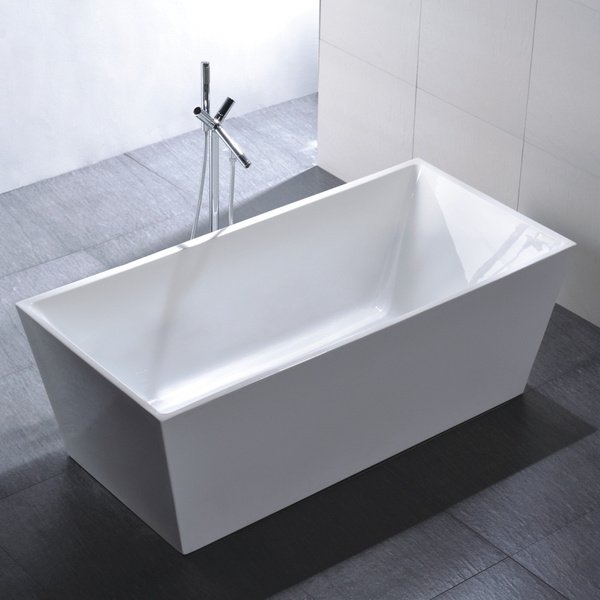Are you feeling torn and overwhelmed about choosing between a Porcelain and Acrylic Bathtub for your home tub? Well, it’s completely understandable! Making the decision to invest in a new bathtub can be an exciting yet stressful process.
Acrylic tubs are cheaper than porcelain due to lower material and production costs, while porcelain requires more resources and expertise to manufacture. Even though porcelain tubs are heavier and more expensive, they are less likely to scratch or discolor and require more support for installation. Another key difference is that acrylic tubs retain heat better because of the low thermal conductivity and non-porous surface whereas porcelain tubs have lower heat retention due to its dense material applied over cast iron or steel/metal base.
It’s only natural to want to find the perfect bathtub that not only suits your needs but also evokes a sense of relaxation and comfort. Today, I’ll tell you the differences between Porcelain and Acrylic Bathtubs, so you can make an informed decision that feels good both practically and emotionally.
Related Reading
Top 10 Best Acrylic Bathtubs in 2023 with Reviews
What is Acrylic?
Well, acrylic is a type of synthetic polymer or plastic that is derived from acrylic acid. Known by its chemical name, polymethyl methacrylate (PMMA), this material is more preferred by many manufacturers for making acrylic bathtubs.
What is the manufacturing process like ? The process of making acrylic involves the polymerization of acrylic acid, which is a clear liquid with a pungent odor. Mostly, it includes the use of a catalyst, which helps to join the individual molecules of acrylic acid together to form long chains of polymer molecules. The result is a polymer that is a clear, hard, and durable material which is resistant to impact, weathering, and UV radiation.( Some acrylic bathtubs have fiberglass reinforced for durability)
Besides being used to produce a variety of forms , including sheets, tubes, and blocks, it can also be used in paints and coatings. If you want to know step-to-step how acrylic is made, read here.
What is Porcelain?
Porcelain is one type of ceramic material that is made by firing a mixture of kaolin and other materials at high temperatures. The process involves mining and preparing the raw materials, mixing them together and shaping the mixture.
The formed porcelain is then fired in a kiln at high temperatures, typically between 1200°C and 1400°C(2,200 and 2,600 °F) to vitrify, or turn into a glass-like substance, giving the porcelain its characteristic hardness and density.
The end result is a material that is hard, dense, and vitreous, with a smooth and non-porous surface . Porcelain is commonly used in the production of bathtubs , dinnerware, decorative objects, and tiles due to its durability, beauty, and versatility.
Differences Between Acrylic and Porcelain Bathtubs


When it comes to picking up a bathtub, homeowners have many options, including acrylic and porcelain models. While they both serve the same purpose, they mostly differ in a lot of ways. Here are the main differences between acrylic and porcelain bathtubs;
1)Affordability: Cost
| Criteria | Acrylic Bathtubs | Porcelain Bathtubs |
|---|---|---|
| Average Cost | $250-$2000 | $300-$2,500 |
If you torn between acrylic bathtub and porcelain, keep in mind that cost is a significant factor that you need to take into consideration. Firstly, porcelain bathtubs are made from fired clay, so they tend to be generally more expensive than acrylic bathtubs, which are made from a lightweight plastic material.
Next, porcelain bathtubs do have a nice glossy finish that is very resistant to scratches and stains whereas acrylic bathtubs can easily scratch. This also affects cost.
This makes acrylic bathtubs generally the cheaper option compared to porcelain bathtubs. Importantly, this does not necessarily mean that acrylic bathtubs are of lower quality. On the contrary, they are highly durable, easy to maintain, and can last for many years with proper care.
2) Ability to Retain Heat
Acrylic bathtubs are able to retain heat better than porcelain tubs . Surprisingly, its ability to retain heat is because of its low thermal conductivity, which means that it does not transfer heat as quickly as other materials. This makes the water in the tub to stay warm much longer, making it a great option for those who enjoy a relaxing soak.
Since acrylic bathtubs are designed with a non-porous surface , this keeps the water warmer while the smooth and glossy surface of the material prevent heat from escaping through the sides of the tub.
Due to the way they are manufactured, porcelain tubs have a lower capacity to retain heat. This is because a porcelain layer is applied over cast iron or steel – metal base, creating a dense and heavy material that does not insulate heat as effectively as acrylic.
The winner here are acrylic bathtubs- they are able to keep the water temperature consistent for a longer period of time. If you want to evoke feelings of comfort and relaxation, acrylic bathtubs are the Next Gen.
3) Durability
This will surprise you but acrylic bathtubs are the way to go if you want a durable and long-lasting bathtub.
Even though porcelain bathtubs are generally stronger than their acrylic counterparts, they are less durable in the long run. Why is this so?- Porcelain is a brittle material that can easily chip or crack under impact, and it is also more prone to staining and fading over time, making it less resilient than acrylic.
Additionally, acrylic bathtubs are built to withstand the wear and tear of daily use because of its thermoplastic material. which means that it can be molded into different shapes and sizes while maintaining its strength and durability.
Without reservation, acrylic bathtubs are also more resistant and ideal material for bathtubs. So, if you want a bathtub that will stand the test of time and provide you with a comfortable and enjoyable bathing experience for years to come, then an acrylic bathtub is definitely the way to go.
4) Weight
| Bathtub Material | Weight Range (pounds) |
|---|---|
| Acrylic | 50-150 |
| Porcelain | 250-400 |
The average weight of an acrylic bathtub is around 70 to 100 pounds. But, this usually varies on the size of the bathtub. Take for instance smaller acrylic bathtubs, they may weigh around 50 pounds, while a larger one can weigh up to 150 pounds.
On the other hand, porcelain bathtub weigh around 300 pounds. While other sizes can weigh 250 pounds to even 400 pounds depending on the size and design of the bathtub of course. Despite being heavy, porcelain bathtubs are known for their durability and resistance to scratches and stains.
It’s important to note that the weight of a bathtub can also impact the installation process. Heavier bathtubs may require additional support or reinforcement to ensure they are properly installed and do not damage the flooring or structure underneath. Additionally, the weight of the bathtub can also impact the overall weight capacity of the bathroom floor.
When choosing a bathtub, it’s important to consider the weight and ensure that the installation process and bathroom structure can support the weight of the chosen bathtub.
5) Installation
Acrylic and porcelain bathtubs differ in their ease of installation due to a number of factors, including their weight, flexibility, and level of customization.
Let’s start with acrylic bathtubs- these are generally lighter in weight than porcelain bathtubs, which makes them easier to install. They also tend to be more flexible, which can be an advantage when fitting them into tight spaces or irregularly shaped bathrooms.
On the other hand, porcelain bathtubs are heavier and more rigid than acrylic bathtubs, which can make them more difficult to install. They also require stronger support and reinforcement to prevent damage to the bathroom floor and structure. This can make installation more complex and time-consuming.
6) Cleaning and Maintenance
Which is easier to clean up? Well, acrylic bathtubs are generally easier to care for than porcelain bathtubs. As a non-porous material, acrylic is less prone to scratches, stains, and mildew. This makes cleaning the surface of the bathtub simple and straightforward, often requiring only a mild soap and water solution.
Whereas, porcelain bathtubs are some what more susceptible to scratches and stains, which can make them more difficult to maintain over time. Cleaning porcelain bathtubs often requires stronger cleaning solutions and more elbow grease to remove stubborn stains and marks.
7) Style , Design Versatility
Both acrylic and porcelain bathtubs offer a range of styles and design versatility to fit a variety of bathroom aesthetics. Acrylic bathtubs have a better flexibility and moldability, which allows for a wide range of shapes and sizes. This means that you will be able to fully customize to fit into nearly any bathroom space.
In fact, acrylic bathtubs come in a variety of finishes such as glossy, sleek to matte and textured, which makes them a popular choice for those looking for a specific design aesthetic.
Nevertheless ,porcelain bathtubs often have a classic, timeless look that can add a touch of elegance to any bathroom. They too do come in a variety of shapes and sizes, from traditional clawfoot tubs to modern freestanding models and mostly come in typically white or off-white in color, but can also come in a range of colors and patterns to fit specific design preferences.
Note: In terms of design versatility, both acrylic and porcelain bathtubs can be customized with a range of features, such as built-in jets, armrests, and lumbar support, to enhance the bathing experience. Ultimately, your choice between acrylic and porcelain bathtubs will depend on personal style preferences and the desired aesthetic for the bathroom.
How Long Do Acrylic and Porcelain Bathtubs Last?
On average, a well-maintained acrylic bathtub can last anywhere from 10 to 20 years. Whereas, some porcelain tubs may start to show signs of wear and tear after 10-20 years of use, while others may last for 30-50 years or more. Regular cleaning and avoiding abrasive cleaning tools can help prolong the life of a porcelain bathtub. However, even with proper care, some porcelain tubs may develop cracks, chips, or other damage over time. If a porcelain tub is showing signs of significant wear or damage, it may be time to consider replacing it.
Tips for Maintaining Acrylic and Porcelain Bathtubs


1) Regular Cleaning
Acrylic and porcelain bathtubs should be cleaned regularly to prevent buildup of soap scum, mildew, and other debris. To clean;
- Use a soft sponge or cloth with a mild cleaning solution, such as dish soap and water or a specially formulated bathtub cleaner.
- Scrub gently in a circular motion, paying extra attention to any areas where buildup has occurred.
- Then rinse with water and dry or a soft cloth.
2)Avoid Harsh Chemicals
Avoid using harsh chemicals on your acrylic or porcelain bathtub, as they can cause damage to the surface. This includes bleach, ammonia, and abrasive cleaners like scouring pads. Instead, use a gentle cleaner designed specifically for bathtubs, or a mixture of baking soda and vinegar.
3) Use Soft Tools
When cleaning your acrylic or porcelain bathtub, use soft tools to avoid scratching or damaging the surface. This includes soft sponges or cloths, gentle scrub brushes, and non-abrasive cleaning pads. Avoid using hard tools like metal scrubbers, as they can scratch the surface and cause damage.
4) Prevent Stains
To prevent stains from forming on your acrylic or porcelain bathtub, avoid leaving soap or shampoo bottles on the surface for extended periods of time. Also, be careful not to leave metal objects in the bathtub, as they can cause rust stains. Again, if stains do occur, baking soda can help remove stains.
5) Regular Maintenance
In addition to regular cleaning, it’s important to perform regular maintenance on your bathtub to keep it in good condition. This includes checking for any cracks or chips in the surface, as well as ensuring that the caulk around the edges of the bathtub is in good condition. .
Frequently Asked Questions
Do acrylic tubs turn yellow?
Acrylic tubs can turn yellow over time if exposed to sunlight or harsh cleaning products, but regular maintenance can prevent this.
Are acrylic bathtubs better?
Acrylic bathtubs are a popular choice due to their durability, versatility, and affordability compared to other materials.
Do acrylic tubs scratch easily?
Acrylic tubs are prone to scratching, but minor scratches can be buffed out with a soft cloth and mild abrasive cleaner.
Which bathtub is easiest to maintain?
Acrylic bathtubs are generally easier to maintain than other materials like porcelain or fiberglass, as they are non-porous and resistant to stains and mold.
Can i use bleach on acrylic tub?
While bleach can be effective at cleaning acrylic tubs, it should be used sparingly and diluted with water to prevent damage to the material. Always check with the manufacturer’s instructions before using any cleaning products.
Final Thoughts
In conclusion, choosing between acrylic and porcelain tubs depends on your budget, preference, and lifestyle. While acrylic tubs are more affordable and easier to maintain, porcelain tubs are more durable and have a timeless look. Take time to weigh the pros and cons before making a decision. Happy tub shopping!






